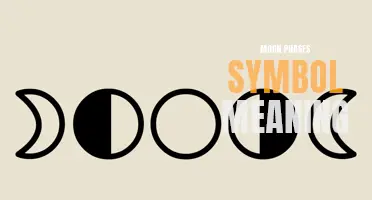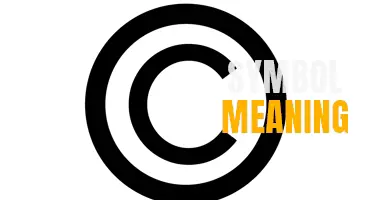
German symbols are rich in history and meaning. From the black, red, and gold of the national flag to the iconic Brandenburg Gate, these symbols embody the spirit and identity of Germany. Each symbol tells a story, representing the nation's values, struggles, and triumphs. Whether it's the eagle symbolizing freedom and strength or the Oak Tree representing endurance and resilience, these symbols hold a special place in German culture and offer a fascinating glimpse into the country's past and present. Join me as we explore the deep meanings and cultural significance behind these german symbols.
What You'll Learn
- What are some common German symbols and their meanings?
- How have German symbols and meanings evolved over time?
- What role do German symbols play in the country's culture and national identity?
- Are there any German symbols or meanings that have controversial or disputed interpretations?
- How do German symbols compare to symbols in other cultures or countries?

What are some common German symbols and their meanings?
Germany is a country rich in history and tradition, and as such, it is home to a variety of symbols that hold special significance. These symbols often reflect the German culture, heritage, and values. In this article, we will explore some of the most common German symbols and their meanings.
- Bundesadler (Federal Eagle): The Bundesadler is the national emblem of Germany. It features an eagle with outstretched wings, clutching a wreath of oak leaves and a shield with the black, red, and gold colors of the German flag. The Bundesadler symbolizes strength, unity, and sovereignty.
- Brandenburger Tor (Brandenburg Gate): The Brandenburg Gate is an iconic symbol of Berlin, the capital city of Germany. It is a neoclassical triumphal arch that dates back to the 18th century. The gate represents peace and unity, as it has been a witness to key historical events, including the fall of the Berlin Wall.
- Oktoberfest: Oktoberfest is the world's largest Volksfest (beer festival). It takes place annually in Munich, Germany, and is associated with German culture and traditions. The symbols of Oktoberfest include beer steins, pretzels, lederhosen (traditional German clothing for men), and dirndls (traditional German clothing for women).
- Black Forest Cuckoo Clock: The Black Forest cuckoo clock is a traditional German timepiece that originated in the Black Forest region. It is known for its intricate carvings and the sound of a cuckoo bird announcing the hour. The clock symbolizes the precision and craftsmanship of German engineering.
- Berlin Wall: The Berlin Wall was a barrier that divided Berlin for nearly 30 years during the Cold War. Its fall in 1989 symbolized the end of the Cold War and the reunification of East and West Germany. The Berlin Wall has become a symbol of freedom, unity, and the triumph of the human spirit.
- Christmas Markets: Christmas markets, known as Weihnachtsmärkte in German, are a beloved holiday tradition in Germany. These markets feature stalls that sell crafts, gifts, food, and drink. Christmas markets are known for their festive decorations, such as Christmas lights, ornaments, and the iconic Christmas pyramid.
- Neuschwanstein Castle: Neuschwanstein Castle is a fairy-tale-like castle located in Bavaria, Germany. It was built by King Ludwig II in the 19th century and is known for its majestic appearance and scenic surroundings. The castle has become a symbol of romanticism and inspiration for various works of art.
- Autobahn: The Autobahn is Germany's network of highways famous for their high-speed limits or lack thereof. The Autobahn symbolizes German engineering prowess and efficiency. It is also associated with Germany's passion for automobiles, as the country is home to several renowned car manufacturers.
These are just a few examples of the many symbols that hold significance in German culture. Whether they represent national pride, historical events, or cultural traditions, these symbols reflect the diverse and vibrant aspects of German identity.
Unveiling the Mystery Behind Dyson Fan Symbol Meanings
You may want to see also

How have German symbols and meanings evolved over time?
Symbols play a crucial role in every culture, and they often reflect the values, beliefs, and identity of a nation. Germany, with its rich history, has seen the evolution of symbols and their meanings over time. From the ancient Germanic tribes to the modern Federal Republic of Germany, these symbols have undergone significant changes, reflecting the country's changing political, social, and cultural landscape.
One of the oldest symbols associated with Germany is the Black Eagle. This mythical creature has been a symbol of power and royalty since ancient times. It was used by several Germanic tribes, including the Lombards, Hohenstaufens, and the Holy Roman Empire. Over time, the eagle became associated with Germanic knights and later with the German Empire. Today, it is still used as the emblem of the modern German Federal Republic, although it has undergone some modifications to represent the ideals of democracy and unity.
Another significant symbol associated with Germany is the Iron Cross. This military decoration has a long history and was introduced by the Prussian king, Friedrich Wilhelm III, in 1813. Initially awarded for bravery in battle, the Iron Cross later became a symbol of German nationalism and military honor. However, it was also adopted by the Nazis during World War II, which tainted its meaning. After the war, the Iron Cross was reintroduced by the German Federal Republic as a symbol of honor and bravery, but with a revamped design to distance it from its Nazi associations.
The German flag itself has also undergone several changes throughout history. The original colors of the German flag were black, red, and gold, which symbolized the democratic ideals of the 1848 revolution. However, after the rise of the Nazi regime, the flag was changed to the red, white, and black colors associated with the Third Reich. Following the end of World War II and the division of Germany, the flag was again modified to represent the two separate states - West Germany (Federal Republic of Germany) and East Germany (German Democratic Republic). After the reunification of Germany in 1990, the black, red, and gold flag was reintroduced, symbolizing a unified, democratic Germany.
German symbols and their meanings have also been influenced by cultural and historical events. For example, the Brandenburg Gate in Berlin, which was originally a symbol of Prussian military might, later became a symbol of division during the Cold War, as it stood in the "no man's land" between East and West Berlin. However, after the fall of the Berlin Wall in 1989, the Brandenburg Gate became a symbol of unity and freedom, representing the reunification of Germany.
In conclusion, the symbols associated with Germany have evolved over time, reflecting the country's changing political, social, and cultural context. From ancient mythical creatures to modern democratic ideals, these symbols have adapted and transformed to represent the values and identity of the German people. Understanding the evolution of these symbols provides valuable insight into the history and culture of Germany.
Exploring the Rich Symbolic Meanings of Native American Rock Art Symbols
You may want to see also

What role do German symbols play in the country's culture and national identity?
Symbols are an integral part of any culture and play a crucial role in shaping a nation's identity. For Germany, a country with a rich history and diverse culture, symbols hold deep meaning and significance. From the German flag to the national anthem, these symbols evoke a sense of pride, unity, and nationalistic sentiment among its people.
One of the most recognizable symbols of Germany is its national flag, referred to as the Bundesflagge. The flag consists of three horizontal stripes - black, red, and gold. Each color has a specific meaning: black represents determination and strength, red symbolizes bravery and courage, and gold represents generosity and fidelity. The flag holds immense importance as it represents the unity of the German people and their commitment to upholding the values and principles of their nation.
Another prominent symbol of Germany is its national anthem, the "Deutschlandlied" or "Song of Germany." The anthem, composed by Franz Joseph Haydn, is an ode to the German nation and its people. It celebrates their resilience and aspirations for a united and prosperous future. The lyrics of the anthem have undergone several changes throughout history, but the current version, which includes only the third stanza, is widely recognized and embraced by the German population.
Beyond the flag and anthem, there are numerous other symbols that hold significant cultural and historical importance for Germany. The Brandenburg Gate, located in Berlin, is a symbol of German unity and freedom. It was once a symbol of division during the Cold War but now stands as a powerful testament to Germany's reunification and the triumph of democracy.
The German eagle is another emblematic symbol that represents the nation's strength and sovereignty. The eagle, often depicted with outstretched wings and a golden crown, can be found on various German government buildings, coins, and official documents. It has a long history dating back to the Holy Roman Empire and has since been associated with German power and authority.
German cuisine also plays a role in the country's cultural identity. Traditional dishes like sauerkraut, bratwurst, and pretzels are not only popular within Germany but also internationally recognized as symbols of German culinary heritage. These dishes are a source of pride for the German people and are often associated with their rich cultural traditions.
The Oktoberfest, a world-famous beer festival held in Munich, is another symbol of German culture and identity. The festival, which attracts millions of visitors from around the globe, showcases the country's love for beer, music, and traditional Bavarian costumes. It is a celebration of German hospitality and joie de vivre and has become synonymous with German cultural identity.
In conclusion, symbols have a vital role in shaping the culture and national identity of Germany. From the national flag and anthem to iconic landmarks and culinary traditions, these symbols evoke a sense of unity, pride, and heritage among the German people. They serve as a reminder of the country's rich history and its ongoing commitment to its values and principles. As Germany continues to evolve and embrace its multicultural society, these symbols act as a bridge between the past, present, and future, ensuring that the nation's identity remains strong and vibrant.
Understanding the Symbols and Meanings on Yamaha Tach Gauges
You may want to see also

Are there any German symbols or meanings that have controversial or disputed interpretations?
German symbols and meanings have a long and complex history, and like any symbols, they can often be subject to different interpretations and understandings. In this regard, there are a few German symbols and meanings that have controversial or disputed interpretations.
One such symbol is the swastika, which is widely associated with Nazi Germany and the atrocities committed during World War II. However, it is important to note that the swastika predates its association with the Nazis and has been used in various cultures for thousands of years as a symbol of good luck and auspiciousness. In Hinduism, for example, the swastika is considered a sacred symbol representing prosperity and good fortune. Despite its long history, the swastika remains a deeply controversial symbol due to its association with the horrors of the Holocaust.
Another symbol that has controversial interpretations is the German flag, which consists of three horizontal stripes of black, red, and gold. These colors have various historical associations and meanings, leading to different interpretations. For example, some people associate the black color with the German Empire, while others see it as a representation of the German resistance against the Nazis. The red color can symbolize courage and sacrifice, but it is also associated with the socialist movement in Germany. Finally, the gold color is often seen as a symbol of German unity and democracy. Overall, the German flag can be interpreted in different ways, depending on the historical and cultural context.
In addition to symbols, there are also meanings and phrases in the German language that have controversial interpretations. One such phrase is the German greeting "Heil Hitler," which was commonly used during the Nazi era. Today, using this phrase is illegal in Germany due to its association with the Nazi regime and the atrocities committed during that time. However, in other contexts, the word "heil" can simply mean "hail" or "good health," without any political connotations. It is important to be aware of the historical and cultural context when using German phrases to avoid any unintended controversies or misunderstandings.
Overall, German symbols and meanings can often have controversial or disputed interpretations due to their historical and cultural associations. Symbols like the swastika and the German flag can evoke strong emotions and have different meanings depending on the context. Similarly, certain phrases in the German language can carry controversial interpretations due to their association with Nazi Germany. It is important to approach these symbols and meanings with sensitivity and understanding to avoid perpetuating any harmful or offensive interpretations.
The Symbolic Meaning of the Bumblebee: What Does It Represent?
You may want to see also

How do German symbols compare to symbols in other cultures or countries?
Symbols are an integral part of every culture and country, playing a significant role in representing their unique identity and values. German symbols, similar to symbols in other cultures or countries, reflect the history, traditions, and beliefs of the German people.
One of the most recognizable German symbols is the German flag, consisting of three horizontal stripes: black, red, and gold. These colors have deep historical significance, as they originated from the uniform colors of the soldiers during the Napoleonic Wars. Today, the flag represents freedom, unity, and democracy in Germany.
Another important German symbol is the eagle, which has been associated with power and strength throughout history. The German coat of arms features an eagle with spread wings, holding a shield in its talons. This symbol has been used by various Germanic tribes and dynasties, and it continues to represent the strength and resilience of the German nation.
German architecture is also known for its distinctive symbols. The Brandenburg Gate in Berlin, for example, is a symbol of German unity and peace. This iconic structure has witnessed significant historical events and is now a popular tourist attraction.
Religious symbols also play a significant role in German culture. The cross, representing Christianity, is commonly seen in German churches and cemeteries. The Martin Luther Rose, a symbol derived from the seal of Martin Luther, is associated with the Protestant Reformation and is an important symbol for German Lutherans.
In comparison to symbols in other cultures or countries, German symbols have their own unique characteristics. For example, the French flag features vertical stripes of blue, white, and red, while the American flag consists of alternating red and white stripes with a blue canton containing stars. Each of these symbols represents the values, history, and heritage of their respective countries.
Symbols in other cultures or countries may also vary greatly depending on their historical, religious, or cultural significance. In some cultures, animals or mythical creatures may be commonly used as symbols, while in others, symbols may be more abstract or geometric in nature.
Symbols have the power to unite people and convey a sense of identity and belonging. Whether they are flags, coat of arms, architectural structures, or religious symbols, each culture and country has its own unique set of symbols that contribute to its rich heritage and traditions. German symbols, with their historical and cultural significance, continue to play an essential role in representing the spirit and identity of the German people.
Decoding the International Truck Dashboard Symbols: A Comprehensive Guide to Meanings and Warnings
You may want to see also
Frequently asked questions
The German flag, also known as the tricolor, consists of three horizontal stripes of black, red, and gold. These colors have significant historical and symbolic meaning for Germany. The black stripe represents determination and strength, the red stripe represents bravery and courage, and the gold stripe represents generosity and unity.
The eagle is a prominent symbol in German culture and has been used to represent various aspects of German identity throughout history. In ancient times, the eagle was associated with the god Odin and was seen as a symbol of power and protection. In the modern era, the eagle is often used to symbolize strength, freedom, and national pride.
The Brandenburg Gate is one of the most iconic symbols of Germany and has great historical and cultural significance. Originally built in the late 18th century, the gate has witnessed many key events in German history, including the fall of the Berlin Wall in 1989. Today, it serves as a symbol of unity and peace, and is a popular tourist destination in Berlin.
The Iron Cross is a well-known symbol in Germany, with roots dating back to the 19th century. It was initially used as a military decoration and represented bravery and valor. Over time, the Iron Cross has become associated with German identity and is often used as a symbol of patriotism and national pride.
The German coat of arms consists of a shield with a black eagle on a yellow background. The eagle holds great significance in German culture and represents strength, power, and protection. The black and yellow colors are also associated with Germany, symbolizing determination and unity. The coat of arms is often used to represent the German government and is prominently displayed on official documents and buildings.







